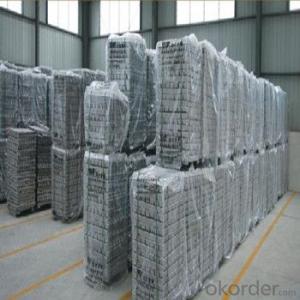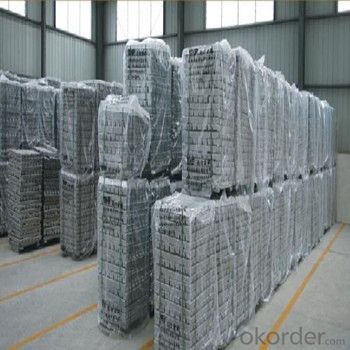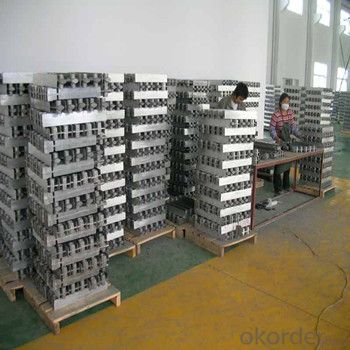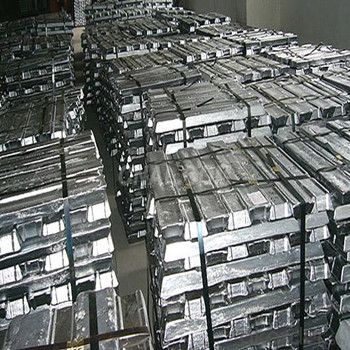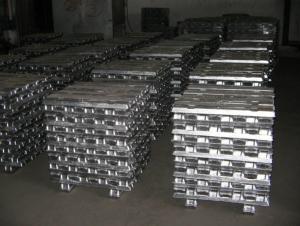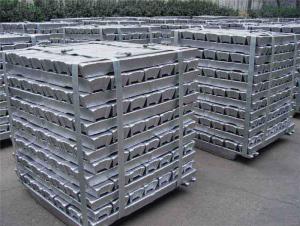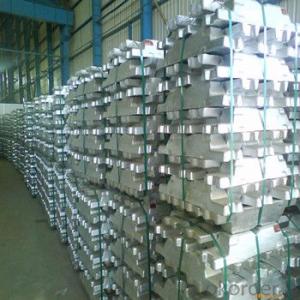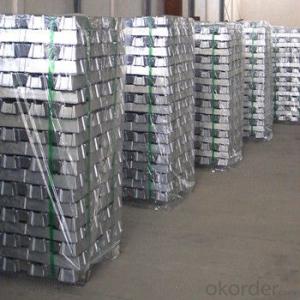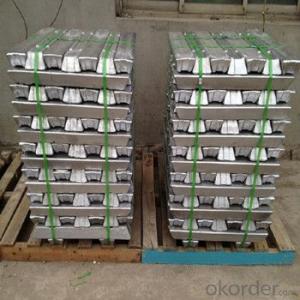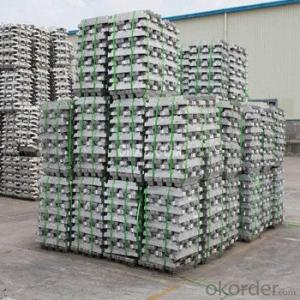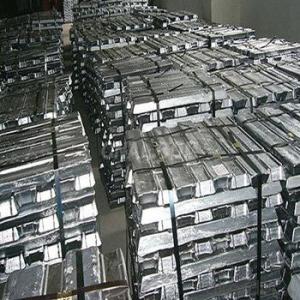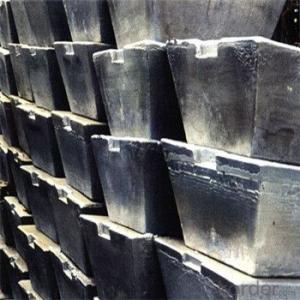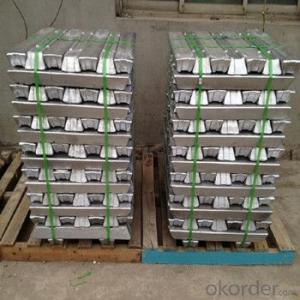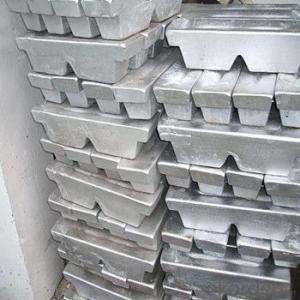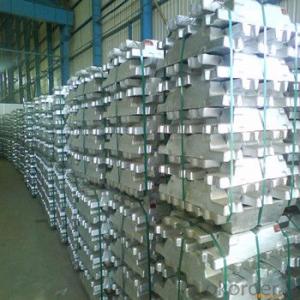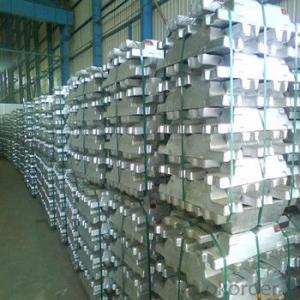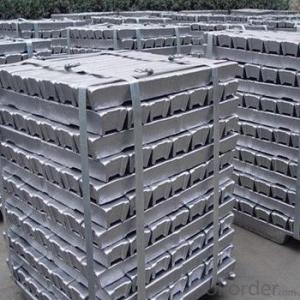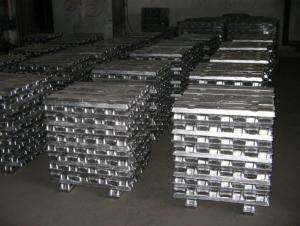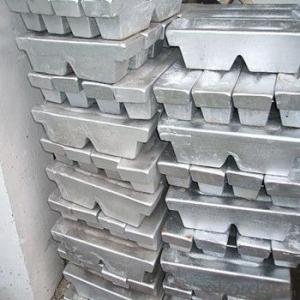Aluminum Ingot From Chinese Supplier Best Quanlity
- Loading Port:
- China main port
- Payment Terms:
- TT OR LC
- Min Order Qty:
- 1000 m.t.
- Supply Capability:
- 10000 m.t./month
OKorder Service Pledge
OKorder Financial Service
You Might Also Like
Pure Aluminum Ingot Used for Industry
1.Structure of Aluminum Ingot Description
An ingot is a piece of material, usually metal, that is cast into a shape suitable for further processing. Insteelmaking, it is the first step among semi-finished casting products.
2.Main Features of the Aluminum Ingot
•Easy control and operation
•Fast melting
•Good price
•Good Service
3. Aluminum Ingot Images
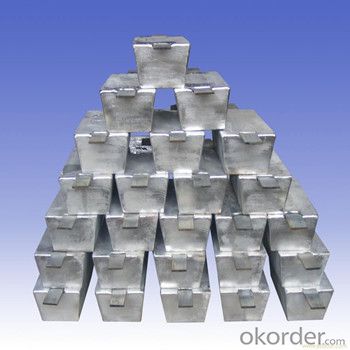
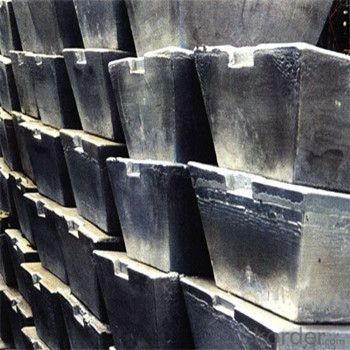
4. Aluminum Ingot Specification
Grade | Chemical Composition % | |||||||||
Al≥ | impurities ≤ | |||||||||
Si | Fe | Cu | Ga | Mg | Zn | Mn | others | Sum | ||
Al99.9 | 99.90 | 0.50 | 0.07 | 0.005 | 0.02 | 0.01 | 0.025 | - | 0.010 | 0.10 |
Al99.85 | 99.85 | 0.80 | 0.12 | 0.005 | 0.03 | 0.02 | 0.030 | - | 0.015 | 0.15 |
Al99.7 | 99.70 | 0.10 | 0.20 | 0.010 | 0.03 | 0.02 | 0.030 | - | 0.030 | 0.30 |
Al99.6 | 99.60 | 0.16 | 0.25 | 0.010 | 0.03 | 0.03 | 0.030 | - | 0.030 | 0.40 |
Al99.5 | 99.50 | 0.22 | 0.30 | 0.020 | 0.03 | 0.05 | 0.050 | - | 0.030 | 0.50 |
Al99.00 | 99.00 | 0.42 | 0.50 | 0.020 | 0.03 | 0.05 | 0.050 | - | 0.050 | 1.00 |
5.FAQ of Aluminum Ingot
We have organized several common questions for our clients,may help you sincerely:
①How about your company?
A world class manufacturer & supplier of castings forging in carbon steel and alloy steel,is one of the large-scale professional investment casting production bases in China,consisting of both casting foundry forging and machining factory. Annually more than 8000 tons Precision casting and forging parts are exported to markets in Europe,America and Japan. OEM casting and forging service available according to customer’s requirements.
②How to guarantee the quality of the products?
We have established the international advanced quality management system,every link from raw material to final product we have strict quality test;We resolutely put an end to unqualified products flowing into the market. At the same time, we will provide necessary follow-up service assurance.
③How long can we receive the product after purchase?
In the purchase of product within three working days, We will arrange the factory delivery as soon as possible. The pecific time of receiving is related to the state and position of customers.Commonly 7 to 10 working days can be served.
- Q: How are impurities removed from aluminum ingots during production?
- Impurities are eliminated from aluminum ingots in the production process through a refining process. The refining process typically consists of two primary steps: degassing and filtration. During degassing, the aluminum melt undergoes high temperatures and low pressures. This assists in the removal of volatile impurities, such as hydrogen, which can lead to porosity and brittleness in the end product. The high temperature and low pressure conditions permit the impurities to escape as gas bubbles, which are subsequently extracted from the melt. Filtration follows as the subsequent stage of impurity removal. The aluminum melt is passed through a filtration system containing ceramic filters or other porous materials. These filters are designed to trap solid impurities like oxides, non-metallic particles, and other foreign materials. The filters possess a specific pore size that exclusively allows the molten aluminum to pass through while retaining the impurities. This filtration process aids in enhancing the quality of the aluminum by reducing the levels of non-metallic inclusions, which can detrimentally impact the mechanical properties of the final product. It also contributes to regulating the grain structure and enhancing the overall homogeneity of the aluminum ingots. In conjunction with degassing and filtration, other refining techniques, such as fluxing and electromagnetic stirring, may also be implemented based on the specific requirements of the production process. Fluxing encompasses the addition of chemical compounds to the aluminum melt to facilitate impurity removal. Electromagnetic stirring employs electromagnetic fields to augment the mixing and distribution of the melt, thereby assisting in impurity elimination. Overall, impurities in aluminum ingots are effectively eliminated during production by combining degassing, filtration, fluxing, and electromagnetic stirring processes. These refining techniques guarantee that the final aluminum product adheres to the desired quality standards and exhibits optimal mechanical properties.
- Q: What are the different forging techniques for aluminum ingots?
- Various forging techniques are utilized for aluminum ingots, each presenting distinct advantages and applications. Some commonly employed techniques encompass: 1. Open-die forging, also termed as smith forging or hand forging, involves shaping the aluminum ingot between flat dies. After heating, the ingot is hammered or pressed into the desired form. Open-die forging is optimal for generating simple shapes and is frequently utilized for crafting customized or unique components. 2. Closed-die forging, also known as impression forging or impression die forging, requires placing the aluminum ingot within a set of dies with a pre-designed cavity. The ingot is then subjected to high pressure, causing it to fill the cavity and adopt the die's shape. Closed-die forging permits the creation of intricate shapes and tighter tolerances, rendering it suitable for mass production of components. 3. Upset forging entails increasing the diameter or thickness of the aluminum ingot by compressing it between flat or shaped dies. The ingot is positioned horizontally between the dies, and vertical pressure is applied to shape it accordingly. Upset forging is particularly beneficial for manufacturing parts with augmented cross-sectional areas, such as shafts, bolts, or axles. 4. Press forging, also referred to as mechanical forging, employs a mechanical press to exert pressure on the aluminum ingot. The ingot is positioned between the dies, and pressure is gradually and precisely applied, enabling accurate shaping. Press forging is commonly employed to fabricate components with intricate shapes, high dimensional accuracy, and refined surface finishes. 5. Roll forging encompasses subjecting the aluminum ingot to pressure by passing it between a pair of rotating rolls. The rolls possess specially designed contours that shape the ingot as it traverses them. Roll forging is frequently utilized to manufacture elongated, cylindrical components like bars, shafts, or tubes. It yields exceptional dimensional control and surface finish. These forging techniques can be tailored or combined to meet specific requirements, and the selection of the most suitable technique relies on factors such as the complexity of the desired shape, production volume, cost considerations, and material properties.
- Q: How to make aluminium box into aluminium ingot?
- The problem of aluminum is not high. It can be dissolved directly in a dry pan, but it should not be dissolved directly because the aluminum ingot is pure aluminum, and the aluminum case should have impurities.The smoke isn't too big.
- Q: The difference between pure aluminium ingot and aluminium alloy ingotToday I know, aluminum ingot is also divided into pure aluminum ingot, aluminum alloy ingot, what is the difference between them?
- Pure aluminium ingot: Aluminum exists in the surface, in addition to iron (Fe) in ranking the second metal elements, since the electrolysis method was invented, human made from bauxite surface, refining of high purity (more than 99.7%) for pure aluminum, aluminum ingots. Such as direct casting for casting toughness is good but not with strength, poor physical properties.
- Q: What type of spectrometer is used to analyze aluminium ingots?
- The spectrometer has many brands and many models, so you can't ask questions like that.
- Q: Casting aluminum ingot, environmental protection has those requirements?.
- The dust bag dust collector system control calcium carbide furnace, furnace, furnace ferrosilicon aluminum ore furnace bag type dust collector, is the mainstream of calcium carbide furnace, furnace, ferrosilicon furnace development at present, the calcium carbide furnace is high energy consuming production equipment, flue gas residual heat, high temperature flue gas. Therefore, no matter what type of bag filter system, cooling measures shall be taken
- Q: What is aluminium ingot? Is it different from other series of aluminum?
- This you communicate with manufacturers, stripes can be reduced as much as possible
- Q: What kinds of aluminum alloy material are used in casting?
- Aluminum profiles are widely used in furniture: screens, skeletons, various kinds of suspension beams, tables, feet, decorative strips, handles, winding grooves and covers, chairs, tubes and so on. They can be designed and used in a variety of ways!
- Q: How are aluminum ingots used in the production of kitchen utensils?
- Aluminum ingots are used in the production of kitchen utensils as they are melted down and cast into molds to create the desired shape and structure of the utensils. The molten aluminum is poured into the molds, which are then cooled and solidified to form the utensils. This process allows for the production of lightweight, durable, and heat-conductive kitchen utensils that are commonly used in cooking and food preparation.
- Q: What are the impurities found in aluminum ingots?
- Aluminum ingots, the primary raw material for various aluminum products, may contain several impurities that can be classified into metallic, non-metallic, and gas impurities. Metallic impurities found in aluminum ingots consist of elements like iron, silicon, copper, manganese, zinc, and magnesium. These impurities can originate from the raw materials or the equipment used during melting and casting. They have a negative impact on the quality and performance of the final aluminum products, affecting their strength, corrosion resistance, and other mechanical properties. Non-metallic impurities in aluminum ingots include compounds and particles such as oxides, carbides, nitrides, and sulfides. These impurities arise from the presence of oxygen, nitrogen, sulfur, or carbon during production. They can cause defects in aluminum products, like porosity, inclusions, or uneven microstructure, weakening the material and reducing its overall quality. Gas impurities are another type of impurity found in aluminum ingots. Common gases present in the ingots are hydrogen, oxygen, nitrogen, and carbon monoxide. These gases can enter during melting and casting or result from the molten aluminum interacting with the surrounding atmosphere. Gas impurities can lead to internal defects in aluminum products, such as gas porosity or bubbles, impairing their mechanical properties and appearance. To ensure the quality of aluminum ingots and resulting products, rigorous quality control measures are implemented throughout the production process. Techniques like refining, degassing, and filtration are used to minimize impurities in the ingots. Thorough testing and analysis are also conducted to monitor and verify impurity levels, ensuring compliance with industry standards and customer requirements.
Send your message to us
Aluminum Ingot From Chinese Supplier Best Quanlity
- Loading Port:
- China main port
- Payment Terms:
- TT OR LC
- Min Order Qty:
- 1000 m.t.
- Supply Capability:
- 10000 m.t./month
OKorder Service Pledge
OKorder Financial Service
Similar products
Hot products
Hot Searches
Related keywords
